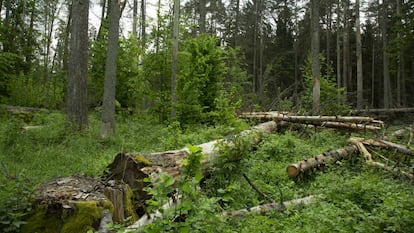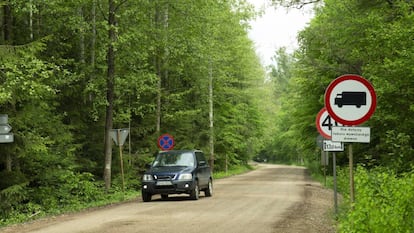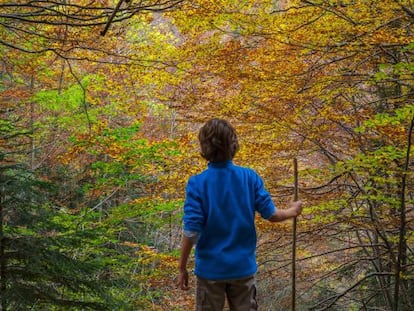The battle over the primeval forest of Bialowieza
The EU stopped logging in Poland’s UNESCO World Heritage Site, but recent government plans have caused fresh alarm among environmentalists

There are around 250 kilometers separating the forest of Bialowieza, on Poland’s northeastern border, from the country’s capital of Warsaw. The three-and-a-half-hour car journey takes visitors along straight secondary roads that cross flat, green countryside for long stretches at a time.
My Portuguese guide, João Ferro, first visited Bialowieza 11 years ago and fell in love with both the forest, which spills into neighboring Belarus, and with a local artist. He returned several years later to settle here himself, close to the national park, which accounts for 10,000 hectares out of a total of 150,000 hectares of forest.
Within the park, which was declared a Biosphere Reserve in 1977 and a UNESCO World Heritage Site in 1979, is one of the last old-growth forests in Europe, accounting for 6,000 hectares. Home to the European bison, this place has seen time stand still for 9,000 years, and human intervention is kept to a minimum. “This landscape is an example of a total balance between different elements in nature,” says Ferro.
Home to the European bison, this place has seen time stand still for 9,000 years, and human intervention is kept to a minimum
However, recent government plans to exploit the forest around the periphery of the park and pave a road cutting through it are causing something of a stir.
In 2016, the national conservative Law and Justice (PiS) government in Poland was responsible for the felling of a large number of trees in areas adjoining the park. This, it claimed, was justified by the need to confront an outbreak of bark beetles that were killing the Norwegian spruce trees. The government’s activity was met with criticism from scientists, environmental associations and the European Commission. In 2017, the EU Court of Justice ruled that Poland should immediately stop the logging. But it wasn’t until they were threatened in 2018 with a €100,000 fine for each day the ruling was ignored that the PiS fell into line and began to play by the rules of this reserve, inscribed in the European network of Nature 2000 spaces.
“Pseudo-ecologists, keep your dirty hands off the forest” reads a sign several kilometers from the park. Slawomir Kropiwnicki has a bar in the area and defends the logging. “Twelve years ago, we had four hectares that were affected by the beetle and the foresters wanted to cut down and burn the trees to curb the outbreak; but the ecologists were against it and now we have 9,000 hectares affected instead,” he says, adding that damaged trees are a danger to people because they can easily fall, the same argument as used by the government in 2016.

“In such cases, the government can cut down the trees, but the trees must always stay in the forest,” says Ferro, who explains that the government’s intervention was illegal because they were taking the wood away to sell. “Felling is also allowed to stock the local market for winter consumption,” he says.
Meanwhile, Tomasz Pezold Knežević, a conservation specialist for biodiversity from the World Wildlife Fund (WWF), says: “You can’t put a stop to an outbreak of beetles as it is part of a natural process.”
Along with other NGOs, it was the WWF that blew the whistle on the Polish government’s activity. “The insects multiply every now and again,” says Pezold as he walks through a clearing. “And here they mainly attack areas where the Norwegian spruces were planted artificially. In the past, the foresters wanted to increase the density of that species, planting more wood that fetches a good market price, but now this tree is very sensitive to climate change. The area has become drier and the spruces are more prone to being attacked by beetles.”
According to Dutch Green Left party MEP Bas Eickhout, both the EU and the activists have been key to stopping the destruction of this unique forest. “The European Parliament put a lot of pressure on the Commission, which took Poland to court following a number of warnings,” he says. “The forest is damaged, but not to an irreparable extent. The EU has proved the ultimate safeguard. Without it, there would not have been any institution to stop the Polish government.”

Now the trees’ immunity is being threatened again. Last year, work began on paving a dirt road some 20 kilometers long connecting the villages of Bialowieza and Narewka. “The institutions reacted and paralyzed the activity,” says Pezold. “The investor has been asked for an environmental-impact assessment to calculate the cost to the environment, and this will allow for a decision to be made on whether it should continue or not.”
Several weeks ago, the new Polish environment minister (the previous one left after the Bialowieza crisis) and the state-run forestry authority declared that they had drawn up new plans for the management of the forest. But the WWF points out that this new plan is once again promoting logging in the area. Days ago, the documents were released for a public-review process, and environmentalists responded with comments to the Polish government, but it is hard to know at this point if any of the comments will be taken into consideration.
Inside the reserve, where nothing can be removed, around 40% of the forest is dead, according to Ferro. “More than 60% of the organisms that exist in Bialowieza are linked to decomposition. They all get re-absorbed into the system, and they will all finish up decomposing to form part of the forest floor. And what we consume is the direct or indirect product of that floor.”
Expanding the national park
Slawomir Dron runs a small café at the gates of the Bialowieza national park. Dron was a candidate for mayor in the elections last November and he expresses concern about the tree-felling. “The Polish government is not cutting down trees yet, but we don’t know what they will do in the future,” he says. “The best thing would be for the whole forest to be designated a national park, as it is in Belarus.”
If that were the case, the entire area would be managed by the national park authority and not by the state-run forestry services, which were responsible for cutting down the trees in 2016.
English version by Heather Galloway.


